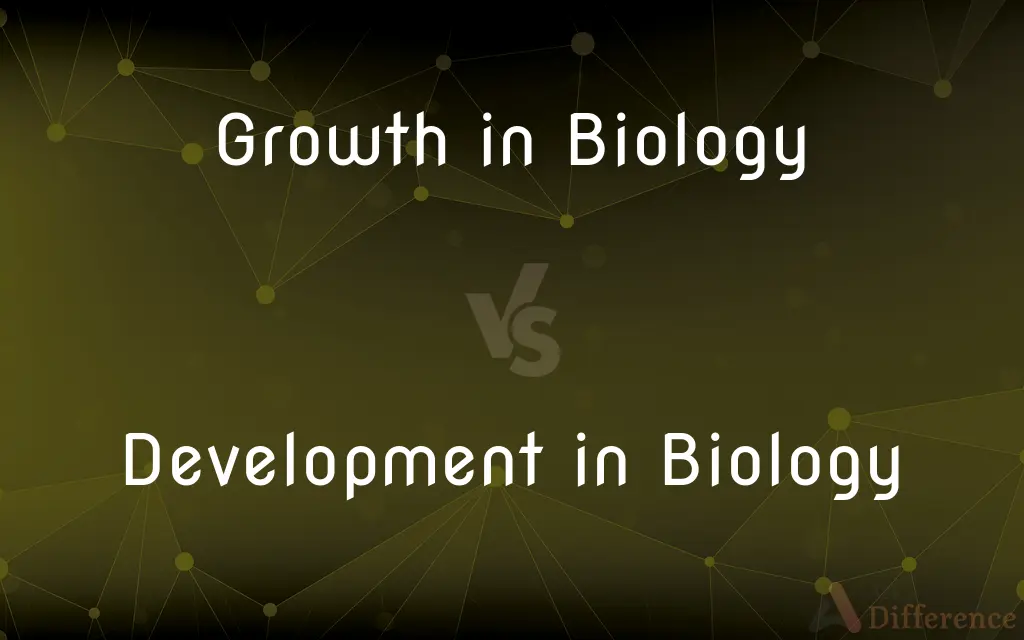Growth in Biology vs. Development in Biology — What's the Difference?
By Tayyaba Rehman — Published on January 29, 2024
Growth in Biology is the increase in size and mass, while Development in Biology involves changes in structure, function, and complexity.

Difference Between Growth in Biology and Development in Biology
Table of Contents
ADVERTISEMENT
Key Differences
Growth in Biology refers to the quantitative increase in size and mass of an organism. In contrast, Development in Biology describes the qualitative changes, such as differentiation and maturation of cells, organs, and tissues.
Growth is a measurable aspect, typically seen as an increase in cell number or size. On the other hand, Development encompasses the organism's entire life cycle, including embryonic development, metamorphosis, and aging.
Biological Growth is usually a continuous process, observed as a physical expansion. Development, however, involves specific stages and milestones, such as the formation of organs during embryogenesis.
Growth can often be quantified, such as by measuring height or weight. Development involves more complex processes like the acquisition of new abilities or behaviors, which are not as easily quantified.
Growth primarily focuses on the physical aspects of an organism's increase, whereas Development covers a broader range of biological changes, including physiological and structural adaptations.
ADVERTISEMENT
Comparison Chart
Nature
Quantitative increase in size and mass
Qualitative changes in structure and function
Focus
Increase in cell number or size
Differentiation, maturation, life cycle stages
Measurement
Often measured in physical terms (height, weight)
Involves complex processes, not easily quantifiable
Continuity
Generally a continuous process
Involves stages and milestones
Scope
Primarily physical expansion
Includes physiological, structural, and behavioral changes
Compare with Definitions
Growth in Biology
Biological growth entails the increase in the number of cells.
Cellular growth in the tissue was evident under the microscope.
Development in Biology
Development can be the acquisition of new behaviors or adaptations.
Birdsong development is essential for territorial and mating behaviors.
Growth in Biology
Growth involves the accumulation of biomass in an organism.
Bacterial growth in a culture results in increased biomass.
Development in Biology
Development involves the differentiation of cells into specialized types.
Stem cell development into various cell types is crucial for organ formation.
Growth in Biology
Growth can be the expansion of an organism's body parts.
The growth of a tadpole's legs signifies its transition to a frog.
Development in Biology
In biology, development refers to the progression from a simple to a more complex form.
Human development from a zygote to a fully formed baby is a complex process.
Growth in Biology
In biology, growth refers to the progressive development of an organism.
The consistent growth of a puppy into a dog is marked by its size and weight increase.
Development in Biology
Biological development includes the stages of an organism's life cycle.
The frog's development through metamorphosis involves significant changes.
Growth in Biology
Growth is the process of increasing in physical size.
The growth of the plant was measured by its increased height over time.
Development in Biology
Development is the process of an organism maturing and acquiring new abilities.
The development of a butterfly includes stages from caterpillar to pupa to adult.
Common Curiosities
What is Growth in Biology?
It's the increase in size and mass of an organism.
Is Development reversible?
Most developmental changes are irreversible.
Can Growth occur without Development?
Yes, organisms can grow without noticeable developmental changes.
What factors influence Growth?
Genetics, nutrition, and environmental conditions.
What does Development in Biology entail?
It includes changes in structure, function, and complexity.
How does Development affect an organism?
It leads to structural, functional, and behavioral changes.
Is Development always accompanied by Growth?
Not necessarily; some developmental stages don’t involve growth.
How do we measure Growth?
Through physical parameters like height, weight, or cell number.
Are Developmental stages predictable?
They often follow a predictable sequence but can vary among organisms.
Can Growth be reversed?
Typically, growth is not reversible.
Is Growth the same in all organisms?
The basic concept is similar, but the rate and pattern can vary greatly.
Is Growth a continuous process?
Generally, yes, it's continuous and gradual.
What factors affect Development?
Genetic programming, environmental interactions, and life experiences.
What are examples of Developmental processes?
Processes like cell differentiation, organ formation, and aging.
Does Growth always mean an increase in size?
Primarily, though it can also refer to cell number increase.
Share Your Discovery

Previous Comparison
Cheez-It vs. Cheese Nips
Next Comparison
Chinese Writing vs. Japanese WritingAuthor Spotlight
Written by
Tayyaba RehmanTayyaba Rehman is a distinguished writer, currently serving as a primary contributor to askdifference.com. As a researcher in semantics and etymology, Tayyaba's passion for the complexity of languages and their distinctions has found a perfect home on the platform. Tayyaba delves into the intricacies of language, distinguishing between commonly confused words and phrases, thereby providing clarity for readers worldwide.
















































